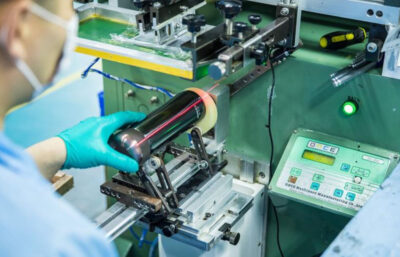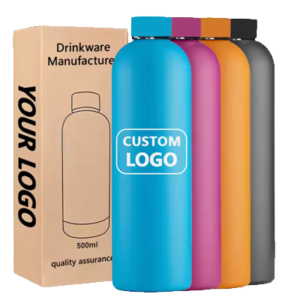What are the usual logo custom options?
Printing the logo is more than just a visual addition—it is a crucial element when customizing water bottle in bulk. A logo embodies a brand’s identity, communicates quality, and highlights the product’s underlying technology. As consumer expectations and manufacturing capabilities continue to grow, the importance of precise, high-quality logo applications has become paramount.
Here’s an overview of the most used logo-printing techniques for custom water bottles on 304 stainless steel other metal material.
Table of Contents
ToggleCommon Logo-Printing Techniques for Bulk Water Bottles
When we start printing logos on the bottles, it’s essential to thoroughly clean the surface to ensure the ink or engraving adheres properly. Any dust, oil, or residue can affect the quality of the print or engraving, leading to poor adhesion, fading, or imperfections over time. Proper surface preparation is a key step to achieving a durable and professional finish.
Surface treatment
LisDifferent surface treatment technologies offer unique finishes, textures, and durability levels, allowing brands to create distinct identities. From colorful spray painting to luxurious electroplating, each method has its own advantages depending on the design goal, target audience, and bottle material. Below, we’ll see several commonly used logo application techniques.
Spray Painting Technology
Spray painting is a versatile technique where paint is directly applied to the surface of the water bottle using a nozzle. This method is particularly adaptable, as it works well with various materials and bottle shapes, offering manufacturers the flexibility to create colorful, vibrant logos. In addition to its aesthetic appeal, spray painting adds a protective layer to the bottle surface, enhancing durability and resistance to external damage such as corrosion.
Electroplating Technology
Electroplating relies on electrochemical principles to deposit a thin layer of metal, such as gold or silver, onto the bottle’s surface. This method produces logos with a polished, luxurious metallic finish. Electroplated logos not only catch the eye with their high gloss but also exhibit excellent resistance to wear and corrosion, making them ideal for premium or high-end water bottle collections.
Atomization Process
This process uses fine particles to create unique logo textures on the bottle’s surface. Atomization can produce subtle matte finishes or creamy textures that elevate the aesthetic appeal of the design. It is especially effective on materials like tempered glass and stainless steel. With its ability to deliver a modern, tactile finish, this method is widely favored for creating sleek, contemporary branding on water bottles.
Partial Polishing
Partial polishing involves refining the area where the logo is applied, resulting in a smooth, reflective surface that contrasts with the rest of the bottle. This process is particularly effective on stainless steel bottles, where the polished logo stands out against a brushed or matte surface. It delivers an elegant, understated look that appeals to consumers seeking sophistication in their products.
Hot Stamping/Silver Stamping Process
Hot stamping transfers metallic or foil logos onto the bottle surface using high temperatures and pressure. The process achieves bold, shiny effects such as gold or silver finishes, creating a luxurious and attention-grabbing logo. This method is often used for water bottles designed for gifting, limited editions, or collaborations, adding a premium touch to the product’s branding.
Engraving Techniques

Laser Engraving Technology
Laser engraving involves using high-energy laser beams to etch a pre-designed logo onto the surface of an object. By adjusting laser parameters to match the logo’s pattern, this process removes a small amount of material, creating a precise and durable design. Logos produced using laser engraving maintain exceptional clarity and detail, even when magnified. This technology is versatile and widely used across various materials, making it a popular choice for creating logos on metal, glass, and even certain plastics.
CNC Engraving Technology
CNC (Computer Numerical Control) engraving is a highly accurate method that uses CNC machines to carve logos onto surfaces based on pre-designed digital models. This technique excels in producing intricate and complex logo designs, making it ideal for projects requiring high precision and fine detail. CNC engraving is especially suitable for high-end products, where the logo needs to reflect both the brand’s sophistication and the product’s craftsmanship.
Hollowing Technology
Hollowing technology involves cutting out specific elements of a logo entirely from the product’s surface, creating an open space or negative space effect. This process can be executed using techniques like laser cutting or CNC machining. Hollowing allows for highly personalized and creative designs, as the logo’s contour lines and patterns can be crafted with complete freedom. The result is a visually striking and unique effect that works well with a variety of materials, including stainless steel, aluminum, and wood.
Advantages of Engraving Techniques
- Durability: Engraved logos are resistant to wear and tear, ensuring they remain intact even after prolonged use.
- Precision: Both laser and CNC engraving produce highly accurate and detailed designs, suitable for complex or intricate logos.
- Versatility: These techniques are compatible with a wide range of materials, including stainless steel, aluminum, glass, and more.
- Aesthetic Appeal: Hollowing adds a distinctive touch, creating logos that stand out with their modern, innovative look.
Transfer Printing
Transfer printing techniques offer a versatile and efficient way to apply logos to products, enhancing their visual appeal and marketability. Here are three commonly used transfer printing methods:
Heat Transfer Technology
Thermal transfer technology involves printing the logo design onto a special thermal transfer film and then transferring the pattern onto the product’s surface using high-temperature pressure. This method produces logos with vibrant colors, realistic effects, and sharp details. Its ability to create high-quality, full-color designs makes it a popular choice in the market for branding products like water bottles, packaging, and accessories.
Silk Screen Printing Technology
Silk screen printing applies logo patterns to a product’s surface using a mesh screen and ink. This technique is straightforward and highly effective, producing logos that are vivid and visually appealing. The textured finish of silk screen printing adds an ornamental quality, making it suitable for a variety of applications, such as printing on packaging, drinkware, and decorative items. Its flexibility allows for printing on both flat and curved surfaces.
Water Transfer Technology
Water transfer technology uses a water-soluble medium and specially designed transfer paper to apply logos to product surfaces. The process involves soaking the printed transfer paper in water and then applying it to the surface of the product. As the water dissolves the carrier film, the pattern adheres to the item, leaving a smooth and detailed logo. This method is ideal for creating logos on irregular or curved surfaces, as it preserves the original texture of the material while enhancing the product’s appearance.
Advantages of Transfer Printing Techniques
- Heat Transfer: Perfect for achieving detailed and colorful designs, with excellent durability.
- Silk Screen Printing: Offers a textured finish that enhances the visual appeal and adds a premium touch.
- Water Transfer: Ideal for complex surfaces, delivering seamless application without altering the material’s texture.
How to Select the Right Logo methods for Bulk Bottles
Choosing the ideal logo production process for bulk bottles requires thoughtful consideration of several factors. Start by evaluating the material and shape of the bottle, as well as the desired logo style and quality requirements. These elements will determine which processes are most suitable for your needs.
The design and color of the logo also play a significant role. For instance, logos with vibrant colors and clear block patterns are best created using spray painting or transfer printing techniques. Laser engraving works well for intricate designs with fine details, while electroplating is ideal for logos with a metallic finish that adds a luxurious touch.
Production scale, time, and cost must also be factored into the decision. Spray painting and transfer printing are efficient and cost-effective for large-scale production, while laser engraving and electroplating are more appropriate for small batches or premium products. Understanding the strengths and limitations of each technique is essential.
Finally, it’s important to research and consult with experts to ensure the chosen method meets your requirements. Finding professional bottle manufacturers or seeking their advice can help you evaluate their capabilities and ensure the final production results align with your expectations.
Selecting the right logo production method is key to achieving high-quality results for our branded bottles. By carefully considering the product’s material, design, and production needs, you can enhance the logo’s visual appeal and durability while effectively promoting your brand. If you are not sure what kind of logo custom method you should choose, you can always talk with Haers Industry Design team for suggestions, or contact us via the online form.


